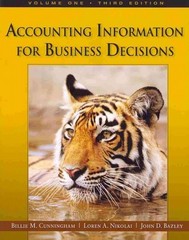Question
Facilities layout, lean manufacturing, brand management, value-added activities. Some firms in the fashion industry have adopted lean or just-in-time approaches to maintain or increase their
Facilities layout, lean manufacturing, brand management, value-added activities. Some firms in the fashion industry have adopted lean or just-in-time approaches to maintain or increase their competitive advantage. Read the following articles or other resources to address the questions below: "Brand-New Bag: Louis Vuitton Tries Modern Methods On Factory Lines (C. Passariello, The Wall Street Journal, October 9, 2006, p. A 1) and "Zara Thrives By Breaking All Rules (K. Capell, BusinessWeek, October 20, 2008, p. 66).
Required
(a) Compare Louis Vuitton's previous and current processes for making a bag. For example, how many people and days are required, wnat are the workers' degrees of specialization, anel what improvements have resulted?
(b) How did Louis Vuitton's previous process for making bags support the company's value proposition?
(c) How have practices from competitors such as Zara changed Louis Vuitton's view of what its target customers want? Has Louis Vuitton's value proposition changed? If so, how well will the new process support the company's value proposition?
(d) What performance indicators do you think are critical in evaluating the performance of this manufacturing operation from the standpoint of customers and the company?
Article :
Zara Thrives by Breaking All the Rules: How the Spanish apparel chain gets new designs into stores in two weeks while keeping costs low Kerry Capell October 8, 2008, 11:00 PM CDT ARTEIXO, SPAIN
Many U.S. apparel retailers are choking on slow-moving inventories as consumers hold back on spending. But Spain's Inditex, whose Zara chain pioneered cheap chic, is zipping ahead. The $13.8 billion company, which is closing in on Gap (GPS) for the title of world's biggest clothing retailer, has nearly quadrupled sales, profits, and locations since 2000. This year, Inditex plans to expand by up to 640 stores. "They will weather the storms better than most of their rivals," says Michael Lewis, a supply-management professor at University of Bath's School of Management. Inditex's secret? Besides selling relatively cheap clothes, which fit the times, the company maintains an iron grip on every link in its supply chain. That enables it to move designs from sketch pad to store rack in as little as two weeks. This "fast fashion" way of doing things has become a model for other apparel chains, such as Los Angeles-based Forever 21, Spain's Mango, and Britain's Topshop, which is set to open in New York next year. Inditex has spent more than three decades perfecting its strategy. Along the way it has broken almost every rule in retailing. At most clothing companies, the supply chain starts with designers, who plan collections as much as a year in advance. At Inditex, Zara store managers monitor what's selling dailyand with up to 70% of their salaries coming from commission, there's a lot of incentive to get it right. They track everything from current sales trends to merchandise customers want but can't find in stores, then shoot orders to Inditex's 300 designers, who fashion what's needed instantly. HIGHER PAY AT THE PLANT Typically, apparel chains outsource the bulk of production to low-cost countries in Asia. Inditex produces half of its merchandise in factories in Spain, Portugal, and Morocco, keeping the manufacturing of the most fashionable items in-house while buying basics such as T-shirts from shops in Eastern Europe, Africa, and Asia. Wages are higher at Inditexits factory workers in Spain make an average of $1,650 a month, vs. $206 in China's Guandong Province. But the company saves time and money on shipping. Also, Inditex's plants use just-in-time systems developed in cooperation with logistics experts from Toyota Motor (TM), which gives the company a level of control that would be impossible if it were entirely dependent on outsiders. In addition, Inditex supplies every market from warehouses in Spain. Even so, it manages to get new merchandise to European stores within 24 hours, and, by flying goods via commercial airliners, to stores in the Americas and Asia in 48 hours or less. Air shipments cost more than transporting bulk packages on ocean freighters. But Inditex can afford them. The company produces smaller batches of clothing, adding an air of exclusivity that encourages customers to shop often. As a result, the chain doesn't have to slash prices by 50%, as rivals often do, to move mass quantities of out-of-season stock. Since the chain is more attuned to the most current looks, it also can get away with charging more than, say, Gap. "If you produce what the street is already wearing, you minimize fashion risk," notes Jos Luis Nueno, a marketing professor at IESE Business School in Barcelona. For rivals hoping to mimic Inditex's results, analyst Luca Solca of Sanford C. Bernstein has a bit of advice: Don't follow the Zara pattern halfheartedly. "The Inditex way is an all-or-nothing proposition that has to be fully embraced to yield results."
Article 2
https://www.wsj.com/articles/SB116035785257486463
Step by Step Solution
There are 3 Steps involved in it
Step: 1

Get Instant Access to Expert-Tailored Solutions
See step-by-step solutions with expert insights and AI powered tools for academic success
Step: 2

Step: 3

Ace Your Homework with AI
Get the answers you need in no time with our AI-driven, step-by-step assistance
Get Started


